John Hurrell – 30 September, 2024
This unusual painting is of a person out at sea rowing a boat. Or trying to. We see an aggressive (somewhat demonic) seagull hovering nearby squawking (up on the right), and we wonder about the direction of the rowing action. Is it going towards stern or bow? Is it moving at all. And which way is the rower facing? He seems to be facing the wrong way. And his peaked hat seems to also be a bird head with a beak.
Today, instead of the usual overall review of an intact show, this post mostly focusses on a single item at Sumer: a twenty-six year old work from the estate of the late Taranaki-based, Argentina-born painter, Tom Kreisler, famous for his openly emotional (wittily jocular but at times, also irritable) stained-on-canvas or drawn-on corrugated cardboard works. These were conspicuous for their love of punning language and spontaneously fluid Thurberesque line. Made by a complex, entertaining though conflicted, personality.
This unusual painting is of a person out at sea rowing a boat. Or trying to. We see an aggressive (somewhat demonic) seagull hovering nearby squawking (up on the right: a ‘monster from the Id’?), and we wonder about the direction of the rowing action. Is it going towards stern or bow? Is it moving at all.
And which way is the rower facing? Is he trying to flee? He seems to be facing the wrong way. And his peaked hat seems also to be a bird head with a beak.
The image is ambiguous, even indecisive—as if the artist doesn’t know what he is making. (Of course he does.) The written letters are peculiar too, but much more knowing in their execution. Some are self-consciously flipped backwards (like in a mirror) and in reverse order.
There is also something else to chew over….Is the painted activity depicting a solitary man coping with rowing, and with its oddball text, a strange comment on writing or drawing with paint? Or is the rower trying to escape something?
Does operating the oars as he does (for a rower/artist/writer) need a thought-out aim or resolute purpose? Is a preplanned desired direction essential? All three are muscular actions using the arms, that normally require co-ordination. Are they on automatic drive, energised by a ‘non-thinking’ reflex-powered motor?
Kreisler’s title for this painting is very curious. It oddly ignores the hapless cove sitting in the centre of the small sail-less craft. It is as if the boat (a possible vague reference to Rimbaud’s famous poem, The Drunken Boat) is really trying to propel itself through the choppy water and strong current. As suggested, it might even be stationary.
The rower we might see as pathetically ineffectual, and being taunted by the creepy screeching gull. He is inconsequential, impactless, and struggling, with ‘emotional’ exasperation lines radiating from his head. There is a suggestion of a symbolic motivation here, behind this work. About life in general, or Kreisler’s own life. It doesn’t seem to be about going fishing, getting to a destination, or getting some exercise.
Amongst the other dozen Kreisler works on display (one on canvas, six on board, one on chipboard, three on cardboard and one on paper) a large number involve language mutilation or punning (eg. chair/cheer: contemporary/ temporarycon/ contemptorary) with brush and acrylic paint; some good natured, others irritable.
Most feature a casual ‘offhand’ method of printed lettering, fastidously avoiding pristine finishes: as if suddenly thought up on the spot and deliberately nonchalant. Normally discarded corregated cardboard-box packaging is used for these as a support and left intact with rips and abrasions.
Their battered appearance is calculated and unrelenting, even when later framed and placed under glass. Ranging in moods from chirpy chuckling (such as a rubbery tap drawn on a splintered warped once-laminated, but now water-damaged, panel) to a more common bitter resentment (like ‘a sky full of bile’) that reeks of paranoia, they resolutely reflect life in all its emotional colours. Often hang-dog and deeply wary, but uplifting and strangely exultant too.
John Hurrell

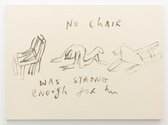
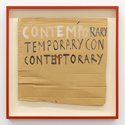
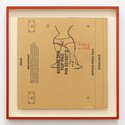
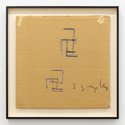
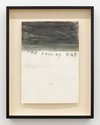

 Two Rooms presents a program of residencies and projects
Two Rooms presents a program of residencies and projects Advertising in this column
Advertising in this column



This Discussion has 0 comments.
Comment
Participate
Register to Participate.
Sign in
Sign in to an existing account.